In a database management system, a DBMS architecture is a fundamental concept to understand how the data is structured in the databases and how it is managed and used by the users. A database consists of significant data that can be securely and swiftly accessed. Therefore, choosing the right architecture is crucial for effective data management. When connecting to the database, users can complete their queries more quickly having a great database architecture than any other tool or technique.
In this article, we will know about DBMS architecture, levels of architecture in DBMS, and types of DBMS architectures such as 1-tier architecture, 2-tier, and 3-tier architecture. We will also look into the challenges to problem-solving that come with defining a DBMS architecture.
What is DBMS Architecture?
A Database Management System (DBMS) is a tool or software that communicates with applications, end users, and the database to collect and process data. It is in charge of organising and managing data so that it may be effectively processed, saved, and retrieved. A database management system’s structure, procedures, and features are specified by its architecture.
Why is database architecture needed? The answer to this is to overcome the problems of the file-oriented system. Because file-oriented systems use many separate and unrelated files, the database, on the other hand, uses different ways to show the change in which user data are stored, accessed, and managed.
Objectives of DBMS Architecture
Ensuring the safety and manageability of your data is the main objective of database architecture in database management systems. It needs to provide dependable manipulation, quick retrieval, and effective storage. Additionally, it lessens redundancy, enhancing data consistency.
The other objectives of DBMS architecture are to:
- Ensure data integrity and security
- Provide efficient data access and management
- Support concurrent user access
- Enable data independence
Components of DBMS Architecture
In DBMS architecture, various components are used to define a good architecture. Together, these elements provide a reliable, effective, and safe database administration system. Here are the primary components of a DBMS architecture:
- Database Engine– The central element in charge of overseeing database functions, such as data modification, retrieval, and storage, is the DBMS engine. It manages concurrency control, transaction management, and SQL query execution.
- Schemas– The logical organisation of the database, including tables, attributes, data types, and relationships, is specified by the database schema. It offers a guide for setting up the database’s structure and data storage.
- Processor for Queries– SQL requests must be interpreted and carried out by the query processor. It guarantees reliable and consistent results by optimising searches for effective data retrieval.
- Storage Manager– The management of data on storage devices, where the actual data is stored, is the work of the storage manager. Apart from this, It also manages the procedures of assigning, retrieving, and managing data in the database.
- Transaction Manager- Ensuring that database transactions are executed correctly is the responsibility of the transaction manager. Through transaction management and concurrency control, it upholds the consistency and integrity of data.
- Data Dictionary- The metadata repository that houses details on the database structure, items, and relationships is called the data dictionary. The data dictionary in DBMS is a collection of names, data elements, and other data contents in the database. It offers crucial metadata for query processing and database administration.

POSTGRADUATE PROGRAM IN
Multi Cloud Architecture & DevOps
Master cloud architecture, DevOps practices, and automation to build scalable, resilient systems.
Levels of DBMS Architecture
The level of DBMS architecture is also known as the three-schema architecture. This architecture contains the different abstraction layers within the database management system. There are three levels in a three-schema architecture including the internal schema or level, conceptual schema or level, and the external schema or level.
These levels help in managing the database complexity and provide different views of the data like how it will look internally, conceptually or logically, and externally (from the user’s perspective). The primary levels of the DBMS architecture include:
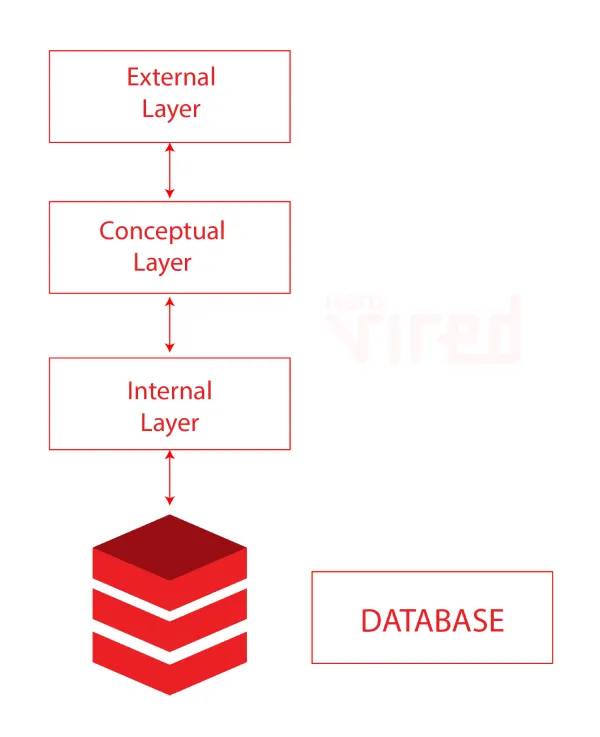
Internal Level (Physical Level)
The first level in the DBMS architecture is the internal level or schema. The internal level in DBMS architecture is also known as the physical level because it deals with the physical storage of the data. In simpler words, it is the physical representation of the database on the computer.
The internal level of the architecture describes how the data is stored in the database. It is concerned with the way data is physically stored on the hardware. Also, note that this internal level covers the physical implementation of the database to achieve optimal runtime performance and efficient storage space utilisation. It focuses on how the data is stored in the database.
The key features of the internal level DBMS architecture are:
- Storage space allocation for data and indexes
- It defines how the data is stored on physical devices, including hard disks, SSDs, and cloud storage.
- The internal level is also involved in organising data files, including the arrangement of records, data blocks, etc.
- It uses different methods to access and manipulate the data in the database like sequential access, random access, indexing method, sorted files, hash filing, etc.
- For compressing the files and data, the internal level is used as the best data compression technique in the DBMS.
Primary operations at the internal level:
- The internal level architecture is used in managing the disc space, allocating the storage spaces, and tracking the locations of data files.
- It also records descriptions for storage with stored sizes for data items.
- The internal level also creates and maintains indexes to speed up data retrieval processes.
- It also helps in dividing the last data basis into smaller databases for easily manageable partitions.
Conceptual Level (Logical Level)
The conceptual level is the global view of the database. The conceptual level is also known as the logical level or schema because it acts as a middle level of extraction in the database. The conceptual level in the database describes what data is stored in the database and what the relationship among the different data stored. The conceptual level provides a unified view of the entire database independent of how the data is physically stored.
It is to be noted that the conceptual view or the logical view represents the entire database. and there is only one conceptual view per database in any database management system.
The key features of the conceptual level DBMS architecture are:
- To represent the structure of the database, the logical level uses the data models.
- To describe the logical structure of the data like tables, attributes, and data types, this uses the schema definition in the database.
- The conceptual level also provides security and integrity information to protect the data from unauthorised access and modifications.
- Being the middle layer in the architecture it provides the logical data Independence wherein the physical level does not affect the conceptual level in the architecture.
- Providing data integrity is the primary feature of the conceptual level of the logical level in the DBMS architecture.
Primary operations of the conceptual level:
- The conceptual level defines the constraints on the data.
- To reduce the redundancy and improve the Data integrity, the normalisation technique is used at the conceptual level.
- To define the relationship between different schemas, mapping is also used at this logical level.
- The conceptual level is also responsible for designing the logical view or the structure of the database known as schema design.
External Level (View Level)
The external level/schema is also known as the users of the database. The external level is the highest level of data abstraction. The external view level insulates users from the details of the internal and conceptual levels. The external level shows that users interact with the database in a way that is relevant according to their needs and can process their queries without showing the complexities of the underlying structures in the database schema.
The key features of the external level DBMS architecture are:
- The external level is also responsible for refining the user-specific views of the database.
- It restricts the access of the users to specific views which are not open to all users and can be seen by only authorised users.
- There may be multiple external schemas created as per different user needs.
- The external level or the view level is created or written using external data definition language.
Primary operations of the external level:
- The external level is responsible for creating and managing user-specific external levels or views of the database.
- The external level processes the queries of the users like retrieving the data and manipulating data in the database.
- Formatting and displaying data for users in an approachable way, frequently via reports or graphical user interfaces.
Advantages of Three-Schema/Level Architecture in DBMS
- Data Abstraction: The different levels of abstraction are provided by data abstraction, which facilitates the management and comprehension of intricate database systems.
- Data independence: It encourages both physical and logical data independence, allowing changes at one level to occur without having an impact on other layers.
- Enhanced Security: A three-schema/level architecture allows for more granular protection by limiting access to sensitive information and offering personalised perspectives.
- Improved Design: It promotes methodical database design and aids in the efficient and logical arrangement of data.
- Flexibility: It enhances usefulness and relevancy by enabling various user groups to have customised views of the data.
Data Independence in DBMS
Data independence is a crucial concept in DBMS architecture, referring to the capacity to modify the schema at one level without altering the schema at the next higher level. The three-level architecture provides data independence in which upper levels are unaffected by the changes in the lower levels. The DBMS includes two types of data independence:
- Physical Data Independence
- Logical Data Independence
Physical Data Independence
The physical data independence in DBMS refers to the capacity to change the internal schema without modifying the conceptual schema. This indicates that the physical storage structures or devices could be changed without affecting the conceptual schema. The change would be absorbed by the map at the conceptual and internal levels. To achieve physical data independence, it requires the internal level of the database and the mapping or transformation from the conceptual level to the internal level.
The physical data Independence criteria require that the conception level does not specify storage structures or the methods like indexing hashing etc., used to retrieve the data from the physical storage medium.
Advantages of Physical Data Independence:
- Performance Optimisation: It allows for changes to the physical storage to optimise performance without affecting the logical schema.
- Scalability: The database can be scaled by modifying the internal schema without impacting the conceptual schema.
- Cost Efficiency: It enables the use of more cost-effective storage solutions and technologies without altering the logical database structure.
Logical Data Independence
Logical data Independence refers to the conceptual schema that can be changed without affecting the existing schema. The ability to modify the conceptual schema without affecting the external schema or user views is known as logical data independence. This implies that modifications to the database’s logical structure, including the addition or deletion of tables or attributes, do not affect how users interact with the information.
In the logical data Independence, the users cannot see the changes in the logical structure of the data. The change would be absorbed by the mapping between external and conception levels. Note that it is difficult to achieve logical data independent from the physical data and dependence because it requires flexibility in the schema design of the database, and the developer has to foresee the future requirements or the modifications in the design.
Advantages of Logical Data Independence:
- Flexibility: It allows the database schema to evolve without disrupting user applications.
- Reduced Maintenance: Changes to the database structure can be made without modifying application programs, reducing maintenance efforts.
- Data Integrity: It ensures that changes to the logical schema do not compromise data integrity or consistency.

82.9%
of professionals don't believe their degree can help them get ahead at work.
Types of DBMS Architecture
In a database, there are various types of DBMS architectures. In the current database management systems, the types of architecture are represented in the form of levels or layers and these layers when combined to form an architecture are called a tier of architecture.
For example, If there are n-tier architecture, then it will contain n-layers in it to represent the database. Like, a 1-tier architecture splits the DBMS into a single layer, a 2-tier architecture divides the DBMS into two layers, a 3-tier architecture into three layers, and so on. Consequently, an n-tier DBMS Architecture separates the entire DBMS into related but n-independent layers or levels. The complexity of the DBMS structure and its level of security rise as the layers in the architecture go higher because of the rising level of abstraction.
Let’s now discuss the three tiers of architecture used in the current systems of the databases:
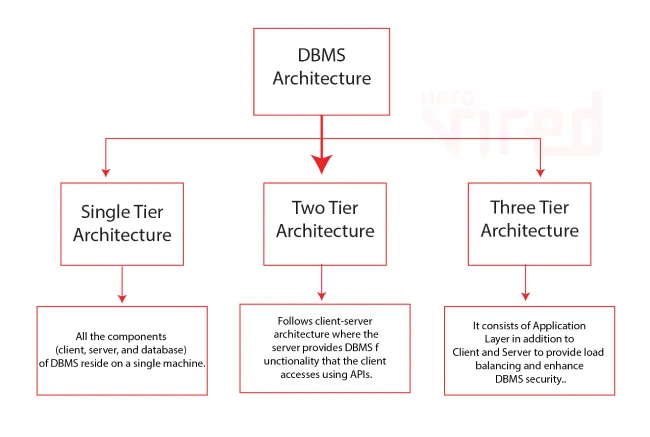
1-Tier Architecture in DBMS
The simplest or the easiest form of DBMS architecture is the 1-tier architecture. This architecture is not commonly used in today’s database management systems. In this architecture, the database and the application interface are tightly integrated to form a single system. The 1-tier architecture is used in applications like standalone applications where the user directly interacts with the database.
The client, server, and database are all located on the same system in a 1-tier architecture, where the user can access the database directly on the DBMS without any method or access.
Features:
- The simplest form of architecture.
- The database application logic and the user interface are all located on a single machine.
- The client can directly access the database without any access restrictions.
- It is suitable for small applications but not for large-scale applications.
- It provides the best performance in small applications.
Advantages:
- It is simple to design and implement.
- The one-tier architecture requires less cost and less network infrastructure.
- This architecture is suitable for programmers, database administrators, and developers.
Disadvantages:
- As the user can directly access the database any unauthorised user can modify the database.
- The 1-tier architecture is not scalable for multi-user or large-scale applications.
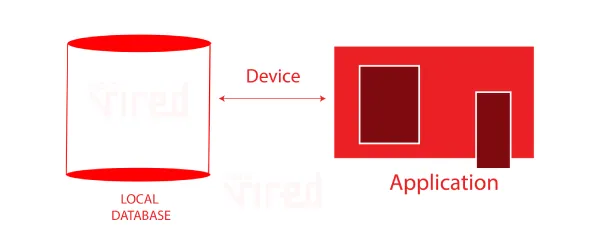
2-Tier Architecture in DBMS
A 2-tier architecture is known as client-server architecture, in which it consists of a client and a server. 28 architecture is commonly known as 2-schema architecture, as there will be two different schemas used to define the architecture. A 2-tier architecture consists of two different layers, the client layer and the server layer, wherein the client layer represents the user interface and the application logic while the server layer is used in managing the storage, database, and processing of the user’s queries.
In a two-tier architecture, the client can communicate with the server to process user queries and access the data from the database. A 2-tier architecture is also known as a connection-oriented architecture because the client has to first establish a connection to communicate with the server and then the transfer of data to a database is performed.
Features:
- It consists of a client and server that interact with the database systems.
- There is direct communication between the client and server to send queries and get the results from the database.
- It is useful for medium to large-scale applications.
- When there are less number of users, a 2-tier architecture is very useful.
Advantages:
- It is useful for small and medium applications where there are a limited number of users.
- It provides scalability.
- It is the simplest form of architecture compared to three-tier architecture.
- It uses less cost as compared to a 3-tier or another-tier architecture.
- It is very simple to implement.
Disadvantages:
- The two-tier architecture is not useful for large-scale applications and has a very large number of users.
- It requires connection, and it is dependent on the network.
- Adding more clients requires more server performance, thereby representing limited scalability.
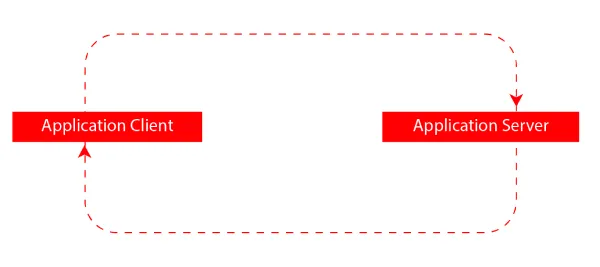
3-Tier Architecture in DBMS
A three tier architecture in DBMS is called a multi-tier architecture as it introduces an additional layer between the client and the server. This additional layer is often known as the middle layer or the application server or middleware that contains the application and the business logic for data processing.
There is no direct communication between the client and the server. The client consists of an application client layer, whereas the server consists of an application server layer. In this architecture, the client communicates with an application server, which connects to the database system through more communication, allowing for the processing of queries and transaction management.
Note that the end user is unaware that the database exists anywhere else than the application server. Additionally, the database is only aware of the application user and not any other external users.
Features:
- Each layer is responsible for specific purposes in the database management system.
- It supports horizontal scaling by distributing the load across multiple servers.
- If one layer is affected, then the other layer is not affected.
- It provides a great level of security.
Advantages:
- It is useful for large-scale applications where there are large numbers of users accessing the database.
- It provides a great level of scalability and can scale each layer independently to handle more user data.
- This architecture is easier to maintain, and each layer can be updated independently as required.
- This architecture provides the highest level of security.
- Data integrity can be seen in this level of architecture.
Disadvantages:
- This architecture requires more infrastructure and operational costs as compared to other architectures.
- The schema design for this architecture is complex and difficult to implement.
- This architecture is not suitable for small-scale or medium-scale applications.
- Scaling the application by adding an extra layer can introduce latency in the processing of data and communication.
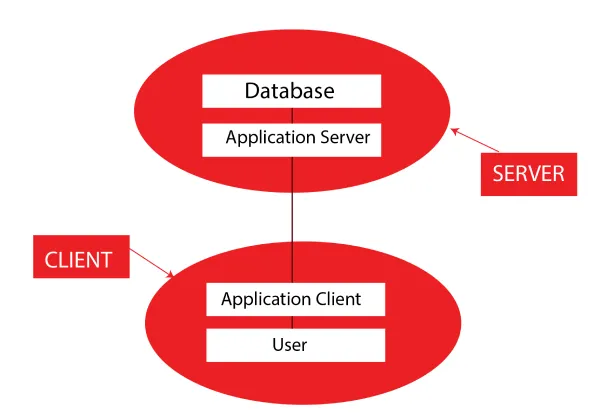
Challenges in DBMS Architecture
Although DBMS architecture offers a strong foundation for data management, several issues must be resolved to get maximum performance and dependability. Here are some of the challenges that may arise in a DBMS architecture:
1. Scalability:
Scalability is a significant challenge in DBMS architecture, particularly as the amount of data and user loads increase. To make sure the database can scale efficiently requires a high level of design and optimisation in both the hardware and software components.
2. Performance:
For a database management system (DBMS) to operate efficiently, its performance must be maintained at a high level. Hardware constraints, data volume, and query complexity are a few examples of variables that can cause performance issues. Addressing performance issues requires optimising data storage, indexing, and user queries.
3. Security:
Ensuring data security is a critical concern in DBMS architecture. The 1-tier level of architecture is less secure, therefore we need to have better architecture. Robust security measures, including encryption, access controls, and frequent security audits, are necessary to guard sensitive data against illegal access and breaches.
4. Data integrity:
It is quite difficult to maintain data consistency in the database especially in today’s scenarios where there are large volumes of data flow, and in concurrent and distributed systems. To have data integrity, we must use the best concurrency control and consistency mechanisms across various locations and throughout concurrent transactions.
5. Data consistency:
Integrating more data from various systems and sources, especially in distributed database management system architectures, is quite challenging. Careful design and execution of data integration procedures are necessary to ensure flawless data synchronisation and integration in the database.
Conclusion
A key component of database system design, implementation, and management is DBMS architecture. In this article, we have seen detailed information on DBMS architecture, three level architecture of database management system, and types of DBMS architectures. We have also seen various challenges that may arise while using DBMS architecture in computer systems. Having an understanding of the internal, conceptual, and external DBMS architectural levels offers a thorough framework for successful and efficient data management. Data independence is ensured by the three-schema architecture, which also improves security and streamlines data management.
Future developments influencing DBMS architecture as technology advances include blockchain technology, cloud-based DBMS, NoSQL databases, AI integration, and so on. Optimising database systems and assuring their dependability and efficiency requires addressing issues with scalability, performance, security, data consistency, and integration. If you want to study DBMS architecture in detail, consider pursuing the Accelerator Program in Business Analytics and Data Science offered by Hero Vired in collaboration with edX and Harvard University.
What does the DBMS's three-schema architecture serve as?
How does the three-layer/schema architecture promote data independence?
- Logical Data Independence: Modifications to the conceptual schema, like altering a table's structure, do not affect application programs or external schemas.
- Physical Data Independence: The conceptual schema is unaffected by modifications made to the internal schema, such as rearranging the way data is stored or indexed. This division enables flexible optimisation of access and storage strategies without interfering with the data's logical structure.
What are the levels of DBMS architecture?
What are the types of database management systems?
What do you mean by data independence?
Updated on February 14, 2025
